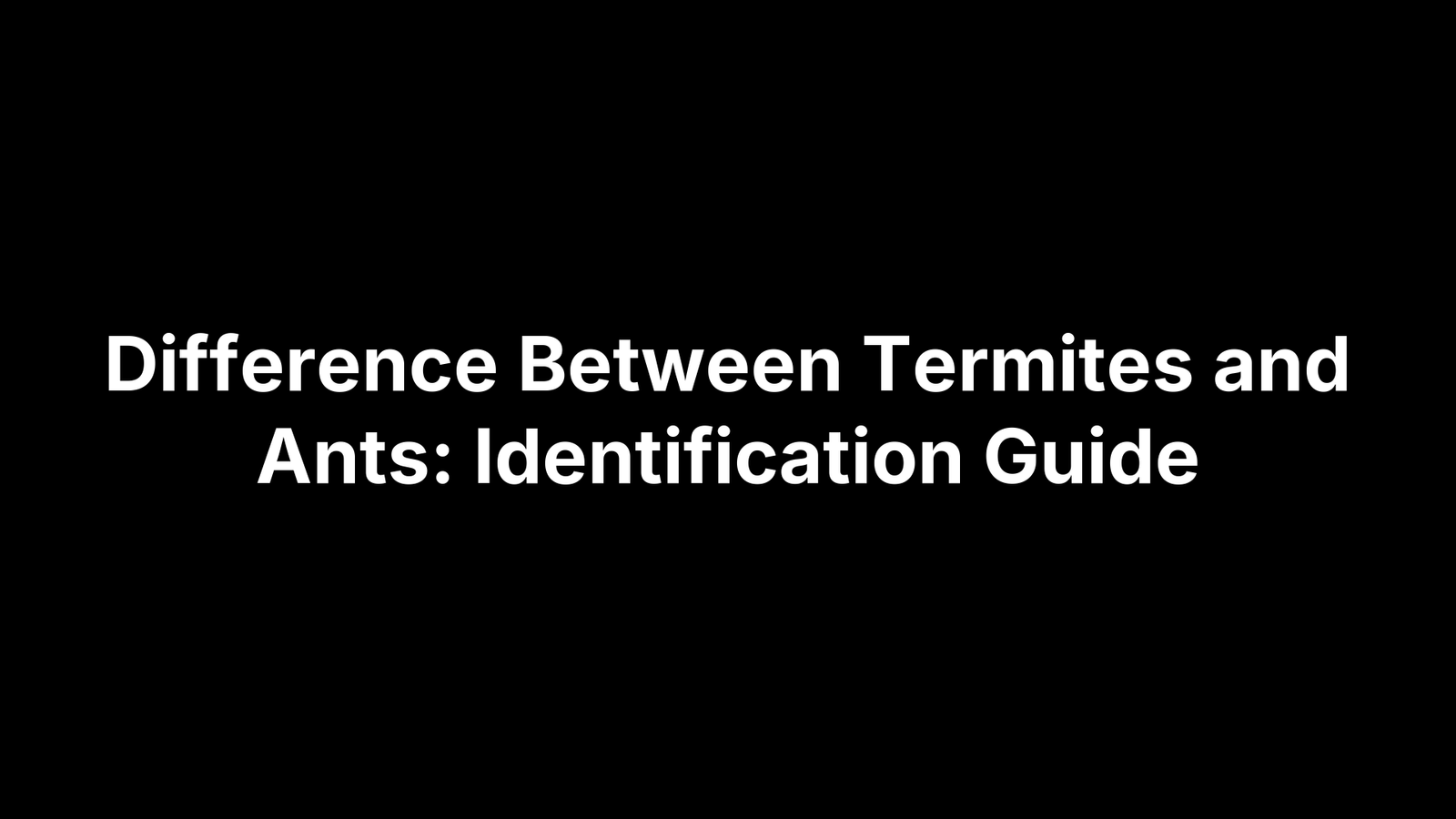Spotting tiny winged insects around your windows or porch? They’re usually either flying ants or termite swarmers—and telling them apart matters. Termites eat wood and can quietly undermine a home, while carpenter ants hollow out damp or damaged wood and typically cause damage more slowly. The quickest visual cues: termites have straight antennae, a thick “no‑waist” body, and two pairs of equal-length wings; ants have elbowed antennae, a pinched waist, and front wings longer than the back pair.
This guide gives you a fast, reliable way to identify what you’re seeing and decide your next move. You’ll get a quick ID checklist, the key physical traits, behavior and habitat differences, the signs to look for, how termite damage compares with carpenter ant damage, when each pest is most active, what to do right now, DIY and safety tips, prevention strategies, and how to document evidence for accurate identification. Let’s start with the quick checklist.
Quick ID checklist: termite vs ant
Use this 10-second scan before you reach for a spray. Look closely at one insect (or a pile of shed wings) under good light. The difference between termites and ants comes down to a few consistent features you can spot without tools.
- Wings: Termites have two equal-length pairs, often longer than the body; ants’ front wings are longer than the back pair.
- Antennae: Termites’ antennae are straight; ants’ are bent/elbowed.
- Waist: Termites have a thick, uniform body; ants have a pinched “wasp‑like” waist.
- Color (workers): Termites are pale/creamy; ant workers are reddish to dark.
- After a swarm: Many identical shed wings near windowsills suggests termites.
- Nearby signs: Mud tubes or soil‑lined tunnels point to termites; sawdust‑like frass suggests carpenter ants.
Key physical traits to look for (wings, antennae, waist, color)
Up close, four simple cues separate a termite from an ant. These features are consistent across common species and are easy to confirm with a flashlight or phone photo. Use them together for the fastest, most reliable termite vs ant identification.
- Wings: Termites carry two equal‑length pairs that often extend past the body and shed easily; ants have two pairs with the front wings noticeably longer than the hind wings. Ant wings also show a more defined vein pattern.
- Antennae: Termites: straight, bead‑like. Ants: bent or “elbowed.”
- Waist/body shape: Termites: thick, uniform body with little to no pinched “waist.” Ants: distinct, narrow waist between body segments.
- Color (workers): Termites: pale/creamy to light. Ants: typically reddish to dark. Because color can vary, prioritize wings, antennae, and waist when in doubt.
Swarmers: flying ants vs winged termites
When colonies mature, both pests release winged reproductives (“swarmers”). They look similar in flight, but key cues reveal the difference between termites and ants. Termite swarms often erupt in spring (frequently after warm rains), are drawn to light, and leave behind many delicate, matching wings. Ant swarms are usually shorter-lived and happen through warmer months.
- Wing shape: Termite swarmers have two equal-length pairs; ant swarmers’ front wings are longer than the hind pair.
- Aftermath: Identical piles of shed wings on sills or by vents point to termites; ant drops often show mixed wing sizes.
- Pairing: Termite king-and-queen pairs quickly drop wings and seek a nest site.
- Where you’ll see them: Around windows, lights, and entry points—especially during spring swarms.
Behavior and habitat differences (diet, nesting, travel)
Knowing how each insect lives helps confirm your ID. Termites are cellulose feeders that tunnel inside sound structural wood and soil, staying hidden as they move through ragged galleries and protective mud tubes. Carpenter ants don’t eat wood; they excavate moist, damaged wood to nest, then forage openly for other foods.
- Diet: Termites eat wood; carpenter ants do not (they feed on other foods and honeydew).
- Nesting: Termites colonize wood and soil; carpenter ants nest in damp, compromised wood.
- Travel: Termites build mud tubes and avoid light; carpenter ants follow visible foraging trails.
- Tunnels: Termite galleries are rough and soil‑lined; carpenter ant galleries are smooth and clean.
Signs you’ll see in and around your home
Before you tear into walls, scan the easy-to-reach spots: windowsills, baseboards, door frames, crawl spaces, sill plates, and the foundation. The difference between termites and ants often shows up as what they leave behind. Use a flashlight and check both inside and outside, especially around moisture-prone areas.
- Termites: Identical shed wings on sills; pencil‑wide mud tubes up foundations or walls; rough, soil‑lined tunnels; wood that sounds hollow or looks water‑damaged; blistered paint or thin veneer over empty galleries.
- Carpenter ants: Coarse “sawdust” frass and wood shavings below small holes; smooth, clean galleries in damp wood; large winged ants or workers foraging openly, especially at night; increased activity near bathrooms, kitchens, or leaks.
Termite damage vs carpenter ant damage
Both pests can weaken your home, but the pace and pattern differ. Termites eat wood, often inside sound structural members, so damage advances faster and stays hidden—significant harm can occur within two to four years and may look like water damage. Carpenter ants don’t eat wood; they excavate damp or damaged areas, typically progressing more slowly and leaving clearer clues.
- Termites: Ragged, soil‑lined galleries; mud tubes; wood that sounds hollow; blistered paint or “spongey” trim; widespread impact to studs, sills, and subfloors.
- Carpenter ants: Smooth, clean galleries; piles of coarse “sawdust” frass with insect parts below kick‑out holes; damage concentrated near leaks, bathrooms, kitchens, or window frames.
Seasonality: when termites and ants are active
Timing is a powerful clue. Termite swarmers are most visible in spring; many species erupt after warm rains and are drawn to lights. Eastern subterranean termites often swarm the day after a good rain in warm weather, while along the coast Formosan swarmers take off at sundown around Memorial Day—both leaving piles of identical, delicate wings.
- Termites: Spring swarms, typically once per year; check windows/lights after storms.
- Carpenter ants: Swarm in warmer months, often several times per year; brief flights.
- Between swarms: Look for mud tubes (termites) or sawdust‑like frass (carpenter ants).
What to do right now based on what you found
Act on what you see so you don’t lose time or destroy helpful evidence. Use the quick ID cues you gathered—wings, antennae, waist, and nearby signs—to pick the right next move and document everything with clear photos and notes.
- If it points to termites: Call a licensed termite pro now. Save samples, wings, and photos of mud tubes or damaged wood; note date, time, and weather.
- If it points to carpenter ants: Vacuum swarmers, fix leaks, dry damp areas, and collect frass evidence; place ant bait along active trails.
- If you saw only swarmers: Check windowsills and lights the next morning for piles of identical wings (termite clue) and capture a sample.
- If unsure: Collect a specimen, take close-up photos (top/side/wings), and get a professional ID and inspection.
- For any case: Reduce moisture and remove rotting wood or wood-soil contact to limit further activity.
DIY options, safety, and when to call a pro
DIY can help with carpenter ants, but termites almost always require a professional. Use the difference between termites and ants to guide your approach: termites eat wood and stay hidden, while carpenter ants excavate damp wood and leave frass. Preserve evidence (wings, tubes, samples) before treating, and don’t knock down mud tubes until inspected.
- DIY for carpenter ants: Fix leaks/dry rot, remove water-damaged wood, seal entry gaps, and place sugar/protein ant baits along active trails. Avoid repellent sprays that scatter colonies. Boric-acid baits can help—follow the label.
- Safety first: Read and follow labels, keep kids/pets away, ventilate, wear gloves/eye protection, never mix products, and store chemicals securely.
- Call a pro immediately if: You see mud tubes or piles of identical wings, hollow/soft wood, recurring swarms indoors, widespread damage, or if DIY fails—or anytime you suspect termites.
Prevention tips for long-term protection
Long-term control starts with moisture management and closing entry points. These steps make your home less attractive to termites that eat wood and to carpenter ants that nest in damp, damaged lumber.
- Eliminate moisture: Fix leaks, clear gutters, improve drainage, ventilate crawl spaces, and use dehumidifiers where needed.
- Break wood–soil contact: Keep structural wood off soil and maintain an inspection gap at the foundation.
- Seal entry points: Caulk cracks and utility gaps; weatherstrip doors/windows; repair screens.
- Replace compromised wood: Remove rotting or water‑damaged sections that attract carpenter ants.
- Use barriers wisely: Sand barriers deter termite tunneling; apply diatomaceous earth along ant entry routes.
- Manage lights during swarms: Reduce outdoor lighting or switch off unnecessary lights to limit swarmer attraction.
- Get proactive checks: Schedule periodic professional inspections, especially after finding wings, frass, or mud tubes.
How to document and share evidence for accurate ID
Collect one specimen in a clear container without crushing it. Take sharp, well‑lit close‑ups from above and the side showing wings, antennae, and waist. Photograph identical wing piles, any mud tubes, frass, and damaged wood, plus one wider context shot. Record date, time, recent weather, and exact locations. Keep wings/debris and notes to share with an inspector.
Frequently asked questions
Here are quick answers homeowners ask most when spotting winged insects or damage. Use these to confirm the difference between termites and ants and decide next steps without losing time or evidence.
- Are flying ants a sign of termites? Not necessarily. Ants can appear without termites.
- When are termites most active? Spring swarms, often after warm rains, near lights.
- Will termites go away on their own? No—professional treatment is typically required.
- Who causes more damage, termites or ants? Termites; damage can escalate within 2–4 years.
- Fastest way to get rid of carpenter ants? Call a pro; fix leaks and use baits if DIY.
Key takeaways
If you remember only a few cues, make them these: termites eat wood, hide in rough, soil‑lined galleries, and leave piles of identical wings; carpenter ants excavate damp wood, leave coarse frass, and are easier to spot foraging. Timing and moisture are your strongest confirmation clues.
- Wings: Termites = two equal pairs; ants = longer front pair.
- Antennae/waist: Termites straight/no waist; ants elbowed/pinched waist.
- Travel: Termites build mud tubes; carpenter ants use open trails.
- Damage: Termites accelerate, look like water damage; ants leave frass.
- Season: Big termite swarms in spring; ant swarms recur in warm months.
If signs point to termites—or you’re unsure—act now. Schedule a professional inspection with Redi Pest Control for fast, precise identification and protection: Redi Pest Control LLC.


